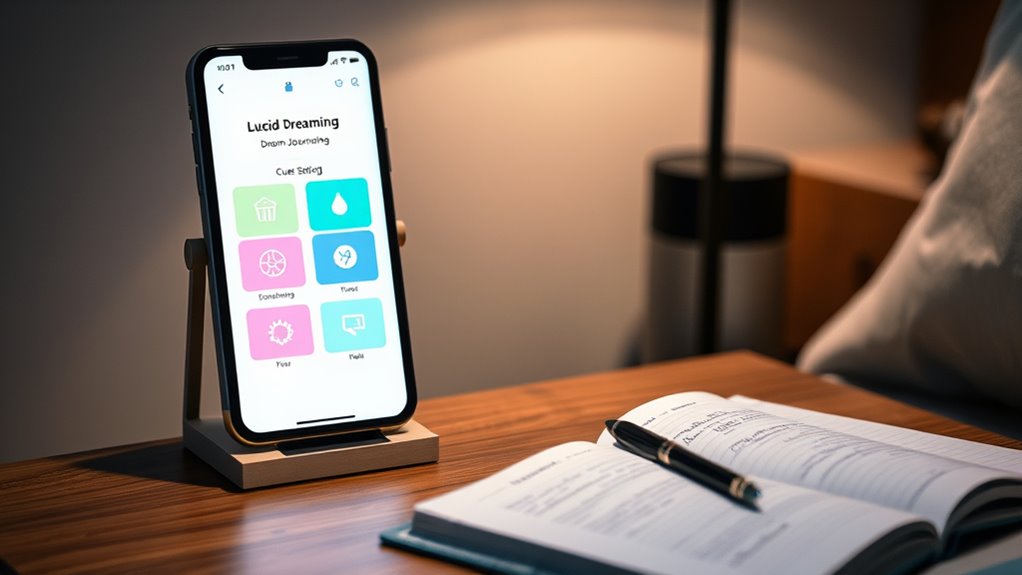To use mobile apps for lucid dreaming, start by setting sleep trackers and alarms aligned with REM sleep, which helps boost dream recall and awareness. Incorporate reality checks by setting reminders or notifications to question your environment during the day, reinforcing the habit. Use the dream journal feature to log your dreams regularly and recognize patterns. Combining these tools increases your chances of becoming lucid. Keep exploring these strategies to discover even more effective techniques.
Key Takeaways
- Use sleep tracking features to identify optimal REM periods for setting alarms or cues.
- Log dreams daily in the app’s journal to recognize patterns and increase recall.
- Set gentle alarms or vibrations during REM sleep to prompt lucidity without disturbing sleep.
- Receive reminders for reality checks during the day to reinforce awareness in dreams.
- Combine sleep data, dream journaling, and reality checks to enhance overall lucid dreaming practice.

Many people turn to mobile apps to enhance their ability to experience lucid dreaming, and these tools can be surprisingly effective. These apps often combine features like sleep tracking and reality checks to help you become more aware of your dreams. Sleep tracking is essential because it provides insights into your sleep patterns, cycles, and quality, enabling you to identify the best times to attempt lucid dreaming. When you understand your sleep stages, you can set alarms or cues to wake you during REM sleep, the phase when vivid dreams occur most frequently. This increases your chances of remembering dreams and recognizing when you’re dreaming.
Mobile apps enhance lucid dreaming with sleep tracking and alerts for better dream awareness.
Reality checks are another cornerstone of mobile apps designed for lucid dreaming. These prompts encourage you to question your environment throughout the day, reinforcing the habit of questioning reality—an essential step in becoming lucid within your dreams. Many apps send periodic reminders or notifications, prompting you to perform a simple task such as pinching your nose and trying to breathe or checking the time twice. Over time, these reality checks become ingrained, making it more likely you’ll perform them in your dreams. When you regularly practice reality checks during the day, you’ll start to do the same while dreaming, helping you realize that you’re in a dream state.
Using these features together is highly effective. For example, some apps allow you to set sleep tracking alarms that wake you during REM sleep, and upon waking, they prompt you to perform reality checks. This approach increases your dream recall and primes your mind to recognize when you’re dreaming. Consistency is key—by logging your dreams in a digital journal within the app, you reinforce your awareness of dream patterns and themes, making it easier to spot signs of dreaming in future dreams. Many apps also include prompts or cues based on your sleep data, such as gentle sounds or vibrations, designed to nudge you into lucidity without fully awakening you. Additionally, maintaining a consistent sleep schedule can improve the accuracy of sleep tracking and increase your chances of successful lucid dreaming.
To maximize these tools, make sure you follow a regular sleep schedule, which helps your sleep cycles become more predictable. Use the app’s data to identify when you’re most likely to experience REM sleep, and plan your lucid dreaming practice around those times. Engage actively with the reality checks, and record your dreams daily. Over time, this integrated approach can sharpen your awareness, improve dream recall, and boost your chances of achieving lucidity. Mobile apps serve as a practical guide, supporting your journey into lucid dreaming with insights, reminders, and a structured method to reinforce your awareness both during sleep and waking hours.
Frequently Asked Questions
How Accurate Are Mobile Apps in Detecting REM Sleep?
Mobile apps’ sleep tracking and REM detection accuracy vary widely. While some use advanced sensors and algorithms, they often can’t match professional sleep studies. You might find that they detect REM sleep reasonably well, but false positives or misses happen. Keep in mind, these apps are helpful for general insights, but for precise REM detection, consider clinical tools. Use them as guides, not definitive sources for sleep health.
Can I Use Apps for Lucid Dreaming if I Sleep With a Partner?
Yes, you can use apps for lucid dreaming even if you sleep with a partner. Consider partner sleep dynamics, like movement or noise, which might affect app accuracy. Look for apps compatible with your device and that offer features like gentle cues or vibrations to signal lucidity without disturbing your partner. Coordinating with your partner and choosing the right app can enhance your chances of successful lucid dreams together.
Are There Any Risks or Side Effects From Using Dream Apps?
You might wonder if using dream apps carries risks, and yes, there are some. You could face privacy concerns if your data isn’t well protected, and sleep disruption if notifications or alerts wake you up frequently. While most apps are safe, it’s smart to verify their privacy policies, set quiet hours, and avoid overusing features that interfere with your rest. Staying mindful helps ensure your lucid dreaming journey stays safe and enjoyable.
How Long Does It Typically Take to See Results?
You might start seeing results in just a few weeks, especially if you consistently use the app for progress tracking and customize it to your needs. Some users notice improved dream recall and lucid dreaming frequency within a month. Keep practicing regularly, set clear cues, and adjust settings as you learn what works best for you. Patience and consistency are key to experiencing the benefits of your lucid dreaming journey.
Do Apps Work Better for Beginners or Experienced Lucid Dreamers?
Think of starting lucid dreaming like planting a seed; apps work well for beginners because they provide simple, tailored User Experience and easy App Customization, helping you grow your skills steadily. Experienced dreamers might find apps useful too, but their familiarity means they often seek more advanced features. For both, the right app acts as a trusty watering can, nurturing your journey into vivid, conscious dreams.
Conclusion
By embracing mobile apps for lucid dreaming, you open the door to vibrant, surreal worlds where your subconscious paints the sky with endless possibilities. Each dream journal entry becomes a stepping stone, guiding you through shimmering landscapes of your mind. As you set cues and track progress, imagine yourself gliding effortlessly through dreamscapes, revealing the mystery of your inner world. With these tools, you’re not just dreaming—you’re mastering the art of vivid, conscious adventure.








